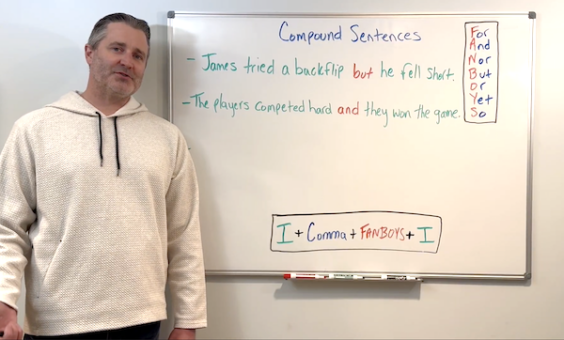By Patty McGee and Tim Donohue
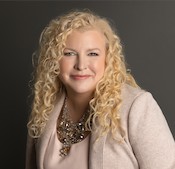 Grammar instruction has barely changed since our grandparents were in school. It’s time to flip that script, starting with sentences. Why? Sentences are the building blocks of writing and the containers of all parts of speech, so beginning at the sentence level is key.
Grammar instruction has barely changed since our grandparents were in school. It’s time to flip that script, starting with sentences. Why? Sentences are the building blocks of writing and the containers of all parts of speech, so beginning at the sentence level is key.
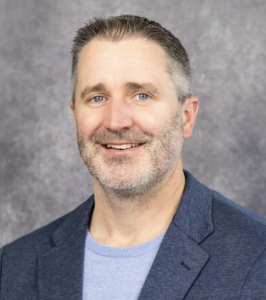 Compound sentences, in particular, are the perfect place to start because they help students combine short, simple sentences, resulting in more varied and sophisticated writing.
Compound sentences, in particular, are the perfect place to start because they help students combine short, simple sentences, resulting in more varied and sophisticated writing.
By transforming our approach to teaching grammar, we can help more students evolve into grammar rock stars. Let’s explore how to join the FANBOYS Fan Club, where the classroom celebrities include coordinating conjunctions.
Meet the Members
Welcome to the world of compound sentences, where the acronym “FANBOYS” isn’t just a bunch of random letters – it’s the list of words that connect independent clauses. FANBOYS stands for:
-
-
-
-
-
-
-
- For
- And
- Nor
- But
- Or
- Yet
- So
-
-
-
-
-
-
Think of these seven little words as sentence superglue; they bond independent clauses together. One student called them “sentence BFFs” because they always bring two complete thoughts together. Clever!
In the days of our grandparents’ grammar instruction, they learned about compound sentences by identifying them on a worksheet or filling in the blanks with the best coordinating conjunction. For most of us, too, this approach didn’t translate into purposeful use in our writing (which is, after all, the intent of grammar instruction).
Try these four phases of learning how to build compound sentences.
The Four-Phase Fan Club Initiation
Phase 1: Begin with a mini inquiry.
Rather than presenting students with a list of rules, ask them to explore a set of simple and compound sentences. Give examples of simple and compound sentences. In partnerships or trios, ask students to explore the following questions: What do you notice is the same and different about simple and compound sentences? What is their relationship to each other? What are you curious about? Then watch as a natural curiosity kicks in.
Some answers we have heard:
- They all have words, but the compound sentences seem to say more.
- Every compound sentence has a comma.
- Both use periods.
- The compound sentences seem longer than simple sentences. Is that true all of the time?
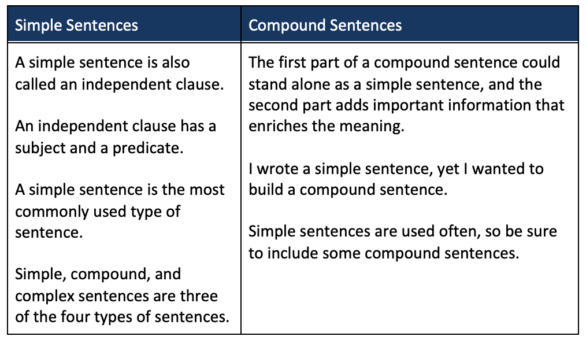
By building theories about the similarities and differences in simple and compound sentences, students develop a sense of curiosity about how they function. This curiosity, often missing from traditional grammar learning, is the bedrock and fuel for constructing grammar know-how.
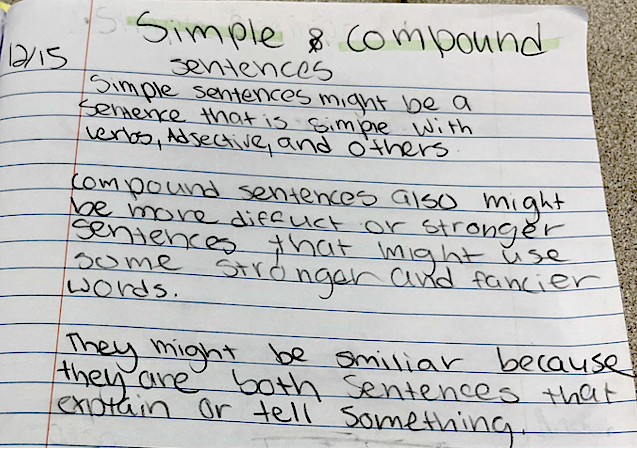 One pair of students wrote their theories down in a notebook.
One pair of students wrote their theories down in a notebook.
Phase 2: Teach explicitly.
Once students have gathered their observations, it’s time for the official introduction to the FANBOYS crew. Using an anchor chart like the one below, show students how to use them and why we need them.
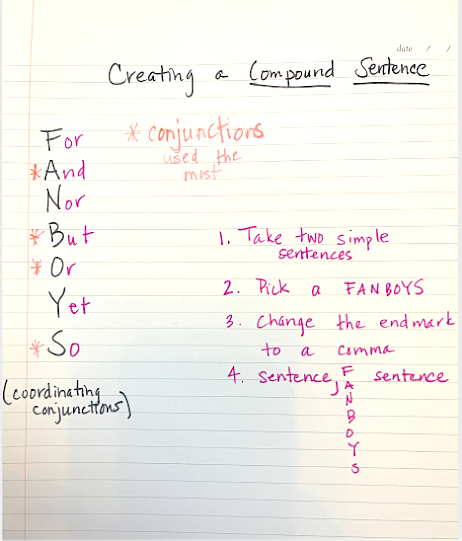
Curious about how the lesson can unfold? Tim has a video for you!
Demonstrate the transformation by turning two simple sentences into a compound sentence: “The dog barked.” + “The mail carrier ran.” = “The dog barked, and the mail carrier ran.”
Then give the students a chance to create a compound sentence using two simple sentences. “Rain poured from the sky.” + “Everyone rushed for shelter.”
Tip: Don’t forget the comma before the FANBOYS.
We have heard students cheer when someone successfully creates a compound sentence. After all, why shouldn’t grammar usage be celebration-worthy?
Phase 3: Use a grammar manipulative.
The “Presto-Change-o” activity gives students scaffolded access to sentence construction. Armed with sentence strips, conjunctions, and commas, they physically manipulate language components to create meaning.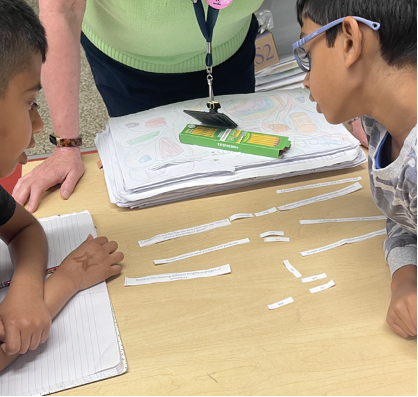
This tactile experience transforms grammar learning from a completion exercise to a creative experience. As students slide their commas and conjunctions between independent clauses, they’re not just following rules – they’re feeling the rhythm of language in their hands.
Students often debate over which one of the FANBOYS choices best expresses the relationship between the clauses. Huzzah! That’s the kind of deep thinking about language that worksheet drills could never inspire.
Phase 4: Reflect on FANBOYS.
True fans don’t just consume – they contemplate. The reflection phase invites students to consider what they’ve discovered about sentence construction and what questions still linger.
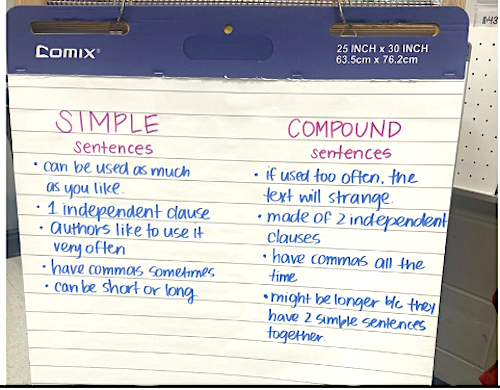
We often hear wonderings such as “I wonder if you can have three independent clauses in one sentence?” or “Is a sentence compound anytime there is a FANBOYS?” Sometimes, these questions lead to impromptu investigations that have the whole class seeking answers.
As John Dewey wisely noted, “We don’t learn from experience. We learn from reflecting on experience.” When students pause to consider their grammatical journey, their insights often surprise and delight even the most seasoned teachers.
Why be a fan of the 4-Phase initiation to the club?
This playful, discovery-based approach works because it transforms grammar from a set of rules into a set of tools:
- Students develop innate motivation when they begin to uncover patterns themselves
- Physical manipulation of sentence parts creates muscle memory for usage in their writing
- Collaborative exploration and conversation lead to deeper understanding than individual worksheets
- Celebrating sentence construction boosts confidence in writing
Remember that membership in the FANBOYS Fan Club isn’t achieved overnight. Mastery develops gradually, building like a snowball rolling downhill – gathering size and momentum with each new experience. Because of this, it’s best to stretch each phase across multiple days.
Joining the FANBOYS Fan Club
By inviting students into the FANBOYS Fan Club, you’re not just teaching grammar; you’re cultivating a community of once-reluctant grammar learners.
And who knows? Some students might start noticing compound sentences in their favorite books (and questioning why authors don’t always use the comma before the FANBOYS). When that happens, you’ll know you’ve achieved the ultimate grammar teacher victory: students who not only understand sentence structure but actually geek out about it – no worksheets required!
So welcome to the club where FANBOYS will energize your students and elevate their writing. Your granny’s grammar lessons never sounded this good!
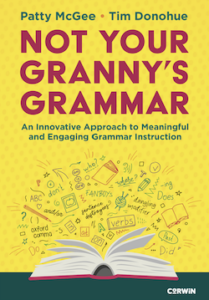 Patty McGee is a veteran teacher and literacy educator. She is the author of Feedback that Moves Writers Forward (Corwin, 2017) and Writer’s Workshop Made Simple: 7 Essentials for Every Classroom & Every Writer (Benchmark, 2021). Her latest book, Not Your Granny’s Grammar: An Innovative Approach to Meaningful and Engaging Grammar Instruction (Corwin, June 2025), written with Tim Donohue, focuses on reinvigorating grammar instruction and includes access to bonus video and web content throughout the book.
Patty McGee is a veteran teacher and literacy educator. She is the author of Feedback that Moves Writers Forward (Corwin, 2017) and Writer’s Workshop Made Simple: 7 Essentials for Every Classroom & Every Writer (Benchmark, 2021). Her latest book, Not Your Granny’s Grammar: An Innovative Approach to Meaningful and Engaging Grammar Instruction (Corwin, June 2025), written with Tim Donohue, focuses on reinvigorating grammar instruction and includes access to bonus video and web content throughout the book.
Patty regularly consults with teachers and principals in Grades K-12 on literacy teaching. Her favorite moments are in the classroom with both educators and students. A former classroom teacher, media specialist, and staff developer, she was a 2002 recipient of the prestigious Milken Award for Excellence in Education. Read her other MiddleWeb articles and follow her at Bluesky and LinkedIn. Visit her website at www.pattymcgee.org and download her free strategy bank for writing instruction.
Tim Donohue is a passionate educator and lifelong learner who lives for those “aha” moments when a student’s eyes light up with understanding. A grammarian at heart and a lover of all things language, Tim is passionate about empowering students to use language and writing as tools for self-discovery and critical thinking.
Tim is a former English teacher and Curriculum Director who currently serves in the role of Assistant Superintendent in Paramus NJ, coordinating all aspects of district curriculum and instruction. Tim holds master’s degrees in English (Writing Studies) and Educational Leadership from Montclair State University. He’s presented at numerous state and local conferences, sharing his expertise and enthusiasm for teaching and learning.


